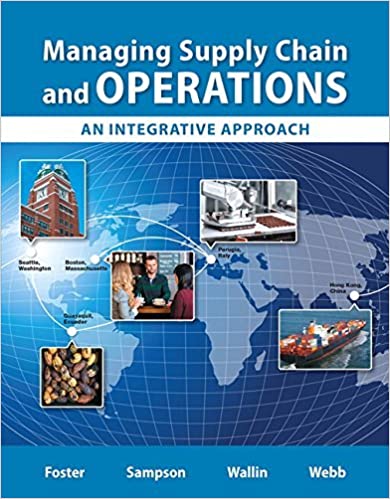
Managing Supply Chain and Operations 1st Edition by Thomas Foster ,Scott Sampson,Cynthia Wallin,Scott Webb
Edition 1ISBN: 9780134110219
Managing Supply Chain and Operations 1st Edition by Thomas Foster ,Scott Sampson,Cynthia Wallin,Scott Webb
Edition 1ISBN: 9780134110219 Exercise 25
Josh Martinez realized that something must be done to increase the output of his facility. Josh had started working at Hamilton Electronics as an hourly employee on the production line while a college student. As the years passed, Josh remained with Hamilton, and assumed a management position upon graduating from college. Currently, Josh manages the assembly line for the company's A25 product. The tasks, task times, and precedent relationships to assemble the A25 are as shown in the table below.  Currently, tasks have been assigned to four workstations, with each workstation having one employee who performs all tasks assigned to that workstation. The current layout is as follows:
Currently, tasks have been assigned to four workstations, with each workstation having one employee who performs all tasks assigned to that workstation. The current layout is as follows:  Josh realizes that the current layout will not provide the needed output to meet the increased demand for the product. The company has asked him to revise the existing line to achieve an output rate of 60 units per hour. The company has also told him that an additional workstation and employee can be used if necessary to achieve the desired rate of output.
Josh realizes that the current layout will not provide the needed output to meet the increased demand for the product. The company has asked him to revise the existing line to achieve an output rate of 60 units per hour. The company has also told him that an additional workstation and employee can be used if necessary to achieve the desired rate of output.
Questions
1. What is the maximum hourly output for the line as it is currently balanced?
2. What is the efficiency and balance delay of the current line balance when it is operating at its maximum rate of output?
3. What is the takt time required to achieve an hourly output rate of 60 units per hour?
4. What is the theoretical minimum number of workstations (employees) required to achieve the desired rate of output?
5. Use the longest operating time rule to assign tasks to workstations so that the desired rate of 60 units per hour can be achieved.
6. Calculate the efficiency and the balance delay of the new line balance you developed in question 5.
 Currently, tasks have been assigned to four workstations, with each workstation having one employee who performs all tasks assigned to that workstation. The current layout is as follows:
Currently, tasks have been assigned to four workstations, with each workstation having one employee who performs all tasks assigned to that workstation. The current layout is as follows:  Josh realizes that the current layout will not provide the needed output to meet the increased demand for the product. The company has asked him to revise the existing line to achieve an output rate of 60 units per hour. The company has also told him that an additional workstation and employee can be used if necessary to achieve the desired rate of output.
Josh realizes that the current layout will not provide the needed output to meet the increased demand for the product. The company has asked him to revise the existing line to achieve an output rate of 60 units per hour. The company has also told him that an additional workstation and employee can be used if necessary to achieve the desired rate of output.Questions
1. What is the maximum hourly output for the line as it is currently balanced?
2. What is the efficiency and balance delay of the current line balance when it is operating at its maximum rate of output?
3. What is the takt time required to achieve an hourly output rate of 60 units per hour?
4. What is the theoretical minimum number of workstations (employees) required to achieve the desired rate of output?
5. Use the longest operating time rule to assign tasks to workstations so that the desired rate of 60 units per hour can be achieved.
6. Calculate the efficiency and the balance delay of the new line balance you developed in question 5.
Explanation
Brief summary of the case:
Mr. J has st...
Managing Supply Chain and Operations 1st Edition by Thomas Foster ,Scott Sampson,Cynthia Wallin,Scott Webb
Why don’t you like this exercise?
Other Minimum 8 character and maximum 255 character
Character 255


